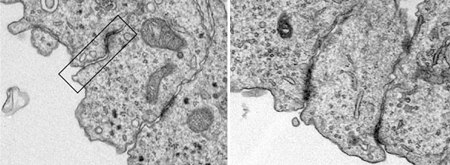| RIKEN Center for Developmental Biology (CDB) 2-2-3 Minatojima minamimachi, Chuo-ku, Kobe 650-0047, Japan |
July 21, 2009 – A new study by Takashi Ishiuchi, Takuji Tanoue and others in the Laboratory for Cell Adhesion and Tissue Patterning (Masatoshi Takeichi; Group Director) sheds light on an unexpected role for a pair of cadherin molecules in the embryonic brain. The group revealed that, in mammals, the little-studied Fat and Daschous cadherins help to organize the apical membrane structure in neural progenitor cells in the cerebral cortex.
The cadherins are a superfamily of transmembrane molecules that are best known for the roles of the classic cadherins in cell-cell junctions, where they help cells recognize other cells of similar type and stick together by a like-binds-like mechanism. But there are other cadherin types as well, some of which are of indeterminate function and much greater size than their classic counterparts. The Fat cadherins, for example, have nearly 7 times the number of extracellular “cadherin repeat” segments than does the typical classic cadherin, E-cadherin; the atypical cadherin, Daschous, is similarly oversized. A number of gross phenotypes have recently been reported in mice lacking Fat4 cadherin (one of the four mammalian Fat cadherins), but the molecular and cellular level mechanisms behind these have yet to be worked out. Ishiuchi began by making antibodies against Fat4 and Daschous1 and using these to map distribution of these proteins by immunostaining, which revealed high concentrations in the cerebral cortex. The two molecules were co-localized in the vicinity of the adherens junction, but unlike the junction proteins beta-catenin and ZO-1, their expression was discontinuous and apically shifted, features that had previously been reported for the distribution of these proteins in Drosophila. Given the known properties of Fat and Daschous in flies, the group next considered they might bind heterophilically (binding between unlike pairs), in contrast to the homophilic binding characteristic of classic cadherins. They transfected Fat4 and Daschous1 into fibroblasts lacking classic cadherins, and found that the molecules became concentrated only at the boundaries between the Fat and Dachsous transfectants, where threadlike filopodia made contact with neighboring cells, suggesting a heterophilic mechanism. This balance between Fat and Daschous was dynamically regulated as well – when Fat4 was depleted, Daschous1 levels dropped. When Dachsous1 was removed, however, Fat4 was upregulated. Looking to the inner side of the junction, Ishiuchi sought after cytoplasmic binding partners of Fat4 and Daschous1, and using immunoprecipitation found that it associated with members of the Pals protein complex. Fat4 co-localized with Pals1 and a second member of the complex, MUPP1, suggesting a functional interaction apical of the cell-cell junction. Interestingly, Pals1 and MUPP1 localized remained even in the absence of Fat4 and Daschous1, indicating that their recruitment to the apical region relies on a distinct mechanism. To investigate the cellular roles of the complex comprising Fat4, Daschous1, Pals1 and MUPP1, Ishiuchi and co-workers used RNAi to block the functions of each molecule and observed the effects. A minute gap apical to the adherens junction is normally seen between plasma membranes of adjacent cells in the intercellular regional, but when the function of either Fat or Pals was interfered with, this gap disappeared. As this form of intercellular gaps appear to be prominent only in certain cell types, including neural progenitor cells, Fat and Dachsous may exert cell type-specific effects on the organization of the apical membrane. The current work, published in The Journal of Cell Biology, showed both the conserved nature of the molecular properties of the Fat and Daschous cadherins and a new function for these proteins and their binding partners in the mammalian cortex. “We still don’t know how Fat4 and Daschous1 regulate junction structure in the apical region,” says Ishiuchi, “so we are going to need to look at possible functional relationships with other factors that are known to work in that part of the cell, such as Crumbs.” |
|||||
|
|||||
 |
| Copyright (C) CENTER FOR DEVELOPMENTAL BIOLOGY All rights reserved. |
